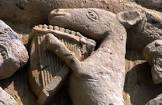It's Saint Patrick's day! One of the most enduring stories about this late-Roman saint is that he drove the snakes out of Ireland. But as I noted in an earlier post about good old Saint Paddy, there actually were no snakes for him to drive out. Pretty much all living things in what is now Ireland, including snakes, had been wiped out by the glaciers, back thousands of years ago, and as the glaciers retreated and plants and animals again reached the British Isles the snakes never made it across the Irish Sea.
Of course for medieval people it was good not to have snakes. Europe doesn't have all the poisonous snakes found in the Americas (and don't get me started on Australia), but they do have the adder, which while not as serious if it bites you as a rattlesnake, is in fact poisonous, and people can die from the bite. Great Britain (the island with England, Scotland, and Wales on it) does have adders, even if Ireland doesn't. So does the European continent (I once almost stepped on an adder in France. It was cool about it.)
The ancient Hebrews weren't fond of snakes either. The story of Adam and Eve, where they are tempted to eat from the Tree of Knowledge after God told them explicitly not to, has a snake as a tempter. The book of Genesis describes the snake as the most sneaky and cunning of all the creatures.
It's not quite clear what the snake's purpose was in tempting Eve, but he certainly paid for it. God cursed all three of them, telling Adam he'd only get food by hard labor in the fields, Eve that she'd bear her children in pain, and the snake that he'd have to go on his belly in the dust. Interestingly, the implication is that up until then snakes had had feet. However, medieval and Renaissance depictions of the Adam and Eve story always have the snake with no feet (though sometimes it has a human face).
The line between snakes and dragons in medieval imagery was rather fluid. Both were a sort of serpent, though dragons would usually have limbs as well as long snaky tails.
Now in fact snakes play an important role in the ecology. Water snakes eat frogs and small fish, and land snakes eat insects, mice, and rats (depending on the kind of snake and how big it is). When you have an animal without predators, it can multiply to the point of causing serious harm to the environment. (Hmm. Humans don't have natural predators other than each other. Let's not talk about that right now.)
© C. Dale Brittain 2025
For more on medieval saints and medieval animals, see my new ebook, Positively Medieval: Life and Society in the Middle Ages. Also available in paperback.



